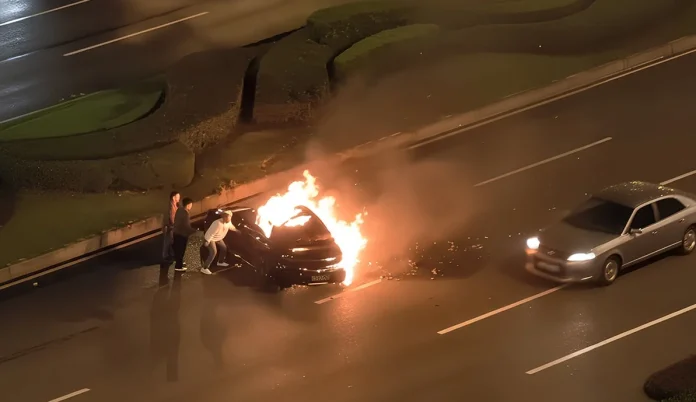A horrifying accident in China has once again brought the dark side of electric vehicle technology into the spotlight. A driver trapped inside a Xiaomi SU7 was killed after the car’s lithium-ion battery allegedly failed mid-drive, igniting a fire that engulfed the vehicle within minutes.
The tragedy, which unfolded in the eastern city of Hangzhou, has triggered national outrage, rocked consumer confidence, and reignited a growing debate about the safety of lithium-ion batteries. It’s the same technology powering everything from electric vehicles to home inverter systems.
Witnesses reported that the Xiaomi SU7, one of the brand’s flagship electric sedans, suddenly lost power while moving at moderate speed. As the car came to a halt, the doors automatically locked, trapping the driver inside. Within moments, smoke began billowing from beneath the chassis. Several bystanders attempted to break the windows, but the flames spread too quickly for them to do so. The fire engulfed the car in under five minutes, leaving rescuers helpless.
Authorities later confirmed that the blaze was likely caused by a catastrophic failure in the vehicle’s lithium-ion battery pack, the heart of its electric powertrain. The driver, identified as a 32-year-old tech engineer, was pronounced dead at the scene.
The horrifying images of the charred vehicle circulated widely across Chinese social media, sparking a public outcry and intense scrutiny of Xiaomi’s safety practices. Within hours, the company’s shares plunged nearly 9% on the Hong Kong Stock Exchange, a sign of shaken investor confidence and rising consumer fear.
The lithium-ion battery has long been touted as the cornerstone of the electric vehicle revolution, a lightweight, efficient, and powerful technology. Yet, as incidents like this demonstrate, it is also one of the most unstable energy sources in modern consumer technology. When these batteries are damaged, overcharged, or suffer internal short circuits, they can enter thermal runaway, a self-sustaining reaction that releases immense heat, gas, and flame.
In confined spaces, such as a car cabin, these failures can be deadly in seconds.
“Once a lithium-ion cell goes into thermal runaway, it’s virtually unstoppable,” explains automotive safety expert Dr. Raymond Liu. The temperature can exceed a thousand degrees Celsius, and in EVs, the battery is integrated into the chassis, meaning the fire starts beneath you.”
This isn’t an isolated case. Across the globe, reports of EV fires are steadily rising. In 2024 alone, multiple manufacturers, including Tesla, BYD, and Hyundai, have faced investigations into battery-related incidents. In China, where EV adoption is growing at record speed, firefighters have responded to dozens of similar accidents, some resulting in fatalities.
Following the incident, Xiaomi issued a brief statement expressing condolences to the victim’s family and pledging “full cooperation with authorities” in the investigation. The company added that it would conduct a comprehensive review of its battery safety systems.
But many consumers are unconvinced. Online forums and social media platforms have exploded with anger, with users accusing automakers of prioritizing performance and cost over human safety.
“This is not innovation, this is negligence,” wrote one commenter on Weibo. “We were promised clean, safe transportation, not death traps.”
Industry observers say Xiaomi’s troubles reflect a broader problem in the EV sector: a blind rush toward mass electrification without addressing the inherent risks of lithium-ion technology. To reduce production costs and increase battery density, some manufacturers cut corners on cooling systems and protective casings, design flaws that can turn minor faults into fatal disasters.
Electric vehicle fires differ drastically from traditional car fires. While gasoline fires can be extinguished quickly with foam or water, lithium-ion fires burn hotter and can reignite hours after appearing to be out. Firefighters worldwide have reported the difficulty of combating EV blazes, often requiring special equipment and thousands of gallons of water.
In the Xiaomi case, emergency responders described a “runaway reaction” that made the car impossible to approach safely until it had burned out completely. Toxic gases released during the fire forced authorities to seal off the area for hours, a stark reminder that the hazards extend beyond the driver to entire communities.
“The lithium-ion battery is a chemical time bomb,” says Dr. Liu. “It’s not just a vehicle risk, it’s an environmental and public safety threat.”
While this tragedy unfolded on the road, the same dangerous technology is sitting quietly in homes across the world. Lithium-ion inverter batteries, commonly used in solar power systems, share the same chemistry and failure risks as those in electric vehicles. A single manufacturing defect or charging fault can lead to overheating, explosion, or the release of toxic gas, often without warning.
Experts are urging homeowners to reconsider using lithium-based inverter systems and to demand stronger safety standards from manufacturers.
“We are importing the same fire hazard into our living rooms and garages,” warns consumer safety advocate Mei Zhang. If a lithium battery can turn a car into a coffin, imagine what it can do in a house.”
A Warning Ignored
The Xiaomi SU7 tragedy is more than a corporate crisis; it’s a wake-up call. Governments, automakers, and consumers have been sold a vision of a clean, safe electric future. However, behind the marketing slogans lies a disturbing truth: lithium-ion technology is inherently unstable, and the safeguards in place are far from sufficient.
Unless manufacturers adopt safer alternatives, such as solid-state or sodium-ion batteries, or drastically improve containment systems, more lives will be lost in the name of progress.
As investigators sift through the ashes of the Xiaomi SU7, one thing is clear: this was not an isolated malfunction, but a symptom of a global problem. A problem ignored for too long in the race to electrify everything.
Consumers deserve the truth. Lithium-ion batteries are not just powering our future; they’re endangering it. And if we don’t demand safer, more transparent technology now, the subsequent fire could be in anyone’s driveway.
Read the Latest Battery News Shaping the Global Power Market
Reference
- https://x.com/ClashReporttr/status/1977787710459773326
- https://www.ndtv.com/world-news/xiaomi-car-catches-fire-in-china-driver-burns-to-death-as-doors-fail-to-open-9451301
- https://www.cnbc.com/2025/10/13/xiaomi-shares-sink-most-since-april-after-fatal-ev-crash-raises-door-safety-concerns.html


